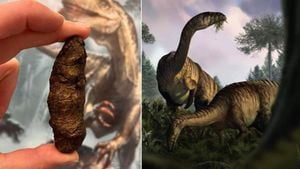Scientists have recently made groundbreaking discoveries about ancient Mars, hinting at the planet's potential past habitability. The research, spearheaded by experts from Curtin University and the University of Adelaide, focused on analyzing what is possibly the oldest concrete evidence of hydrothermal activity found on the Martian surface. Their studies concentrated on a 4.45 billion-year-old zircon grain from the Northwest Africa 7034 meteorite, popularly known as Black Beauty, discovered in the Sahara Desert back in 2011.
This zircon grain provided intriguing insights as it displayed geochemical 'fingerprints' pointing to the presence of water-rich fluids. The findings indicate not only the existence of water but also suggest the conditions under which it existed during the planet's formative years.
Dr. Aaron Cavosie, a co-author from Curtin's School of Earth and Planetary Sciences, commented on the significance of this discovery. "The analysis of the zircon grain opens up new avenues for exploring the ancient Martian hydrothermal systems tied to magmatic activities, and raises questions about the planet's potential for sustaining life long ago. Hydrothermal systems are believed to be pivotal for life on Earth, and our discoveries imply similar conditions may have existed on Mars during its early crust formation," he noted.
The research team employed advanced nano-scale imaging and geochemistry methods to detect elemental evidence of hot water on Mars, affirming its presence approximately 4.45 billion years ago. Through their sophisticated techniques, they identified various elements such as iron, aluminum, yttrium, and sodium. These elements, directly associated with the formation of the zircon, indicated water's presence during the planet's early magmatic activity.
Interestingly, this study builds upon earlier research from 2022, which highlighted the same zircon grain as having been shocked by meteorite impacts, making it the first and only known shocked zircon identified on Mars. Dr. Cavosie stressed how the current findings take their research even farther, allowing them to discern these tell-tale signs of water-rich fluids associated with the zircon grain’s formation, thereby providing geochemical markers of water on Mars's oldest crust.
Despite the significant archaic meteorite impacts Mars's crust has suffered, Dr. Cavosie elucidated how water remained present during the early Pre-Noachian period, which stretches back over 4.1 billion years ago. This suggests water wasn’t merely transient but potentially stable enough to support conditions necessary for life.
The research outcomes were documented thoroughly, with findings published recently in the esteemed journal Science Advances. The work also opens doors for future investigations aimed at unearthing more about early Mars’s environments and their capacities to have supported microbial life.
Across the scientific community, these findings resonate with the age-old quest: was there life on Mars? The implication of stable water, integral for supporting biological processes, strengthens this narrative. Following the footsteps of curiosity cemented by David Bowie's iconic question, one can't help but wonder—if Mars had water during its formative years, did it also nurture life?
Such revelations invigorate the conversation around Mars exploration missions, igniting hopes for potential discoveries as rovers and other spacecraft continue to map and analyze the Martian surface. The prospect of linking geological features with spots indicative of ancient life remains compelling.
Black Beauty, the meteorite central to this study, is not just another piece of rock from outer space; it's famed for its age and the insights it has already provided. With its foundational material dating back to when Mars was still forming its crust, it remains instrumental for scientists trying to piece together the planet's history, particularly concerning water and life.
Researchers believe this zircon grain could lead to more discoveries about hydrothermal processes on Mars. Given Earth's own evolutionary timeline where hydrothermal systems played a key role, the links to Mars's history become even more significant. The data collected from studies like this provide not just evidence of conditions conducive to life but also inform about the planet's geological processes over billions of years.
Moving forward, the insights drawn from the NWA 7034 meteorite can guide future Mars missions and investigations, ensuring we keep searching for more connections between our planet and the Red Planet. Scientifically, this chapter promises to be only the beginning as researchers untangle the threads of Mars's existence and explore whether it truly could have harbored life.



